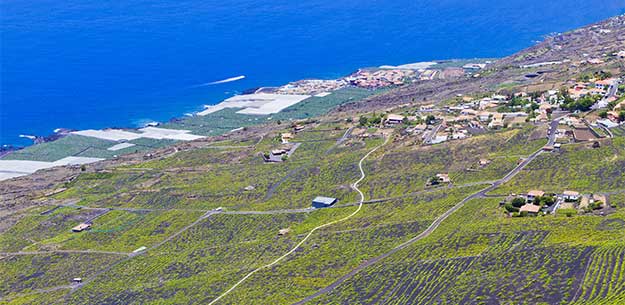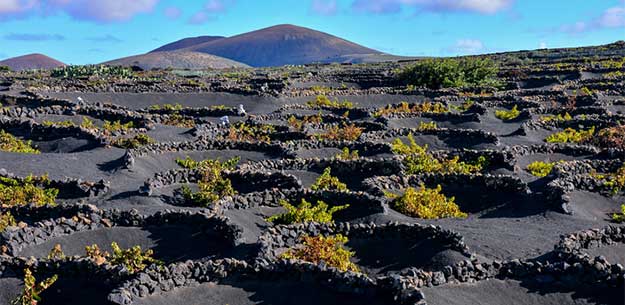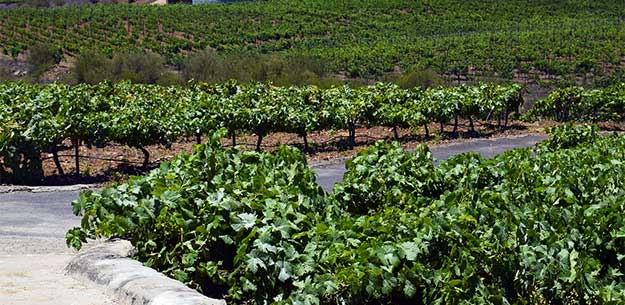.png.transform/rendition-xs/image_image%20(1).png)
Canary Islands Wines: Not Just Malvasía
Endless beaches, leafy woods mixed with lunar desert areas and myriad corners to hide in. In the paradisiacal Fortunate Islands, wine-making is something of a feat. The new generations of Canary wine-growers have succeeded in placing the renowned sweet malvasía wines on the map, along with their dry white, rosé and red wines. The islands have 11 DO regions, shown in alphabetical order.
Abona
A region located in the south of the island of Tenerife with vineyards stretching from the Teide massif to the coastal strip (with an altitude ranging from 1,700 to 300 meters above sea level) including the towns of Adeje, Arona, Vilaflor, San Miguel, Granadilla, Arico and Fasnia.
Young white wines are produced here, mainly with the white listán grape variety, in addition to rosés and reds. While some wineries started up in the mid-20th century, the greatest drive came from the Cooperativa Cumbres de Abona, that together with Cooperativa Agrícola San Miguel Casmi and Bodega Frontos (Grandilla) are the most popular of the DO region.
El Hierro
One of the main virtues of the vines grown on El Hierro is that they were never affected by the phylloxera epidemic and therefore most of the native varieties are maintained. The growing area extends across the whole island. White, rosé, red and sweet wines are made, the first of these the most traditional. Outstanding wineries include El Tesoro, El Ysar and Cooperativa del Campo Frontera.
Gran Canaria
The current DO is the result of combining the Monte Lentiscal DO (including the wine-growing area of Tafira) and the Gran Canaria DO (home to vines from the rest of the island) both awarded in the mid-1990s. In 2004 the producers started to join forces, keeping Gran Canaria as their common name and recognizing Monte Lentiscal as a specific area within the island. Production is mainly white, rosé, red and sweet wines. The main producers are Bodega Las Tirajanas, Bodegas Mondalón and Bodegas Vega de Gáldar.
Islas Canarias
This DO covers all the territory of the Canary Islands that have now more than 80 identified varieties of vines and preserve an extraordinary vine heritage, principally endemic. The PDO Canary Islands allows, mainly, to consolidate the regional market and tackle, assertively, the international commercialization. It shall be the “common brand” to showcase the Canary wine on foreign markets.
La Gomera
The Castilian conquerors (15th century) introduced the vine to the island that reached the height of its splendor in the 17th century. As with other islands, its isolation saved it from the phylloxera epidemic, giving it a varied wine-making history, producing whites, rosés, reds and sweet wines. The main wineries include Bodega Insular, Montoro, and Ramón Barrera González.
La Palma
Its position as a "land of passage" played a key role in the development and trade of wines on the island (15th-16th century); as the westernmost isle it was granted permission to supply provisions to the ships heading to the New World. During this time, malvasía wines were recognized for their quality and were widely appreciated in the main courts of Europe (Shakespeare described it as “a wine that enlivens the senses and perfumes the blood” and it was also mentioned by Goldoni, Walter Scott and Lord Byron).
In the late 19th century, the vineyards were competing for space with banana plantations, a prosperous business on the island, and were also badly affected by the virulent epidemic of mildew and oidium that severely curtailed wine production. With the creation of the La Palma DO in 1994, the sector started to rebuild itself: abandoned vineyards were recovered, new areas were planted and the quality of the wines improved. Vines are grown in the volcanic soils of Fuencaliente-Las Manchas, Hoyo de Mazo-Las Breñas and Norte de La Palma-Vinos de Tea and the wines produced are mostly young although other whites, rosés and reds are also made (the most notable are from the Hoyo de Mazo subzone) while in the Fuencaliente subzone a large portion of the white wines produced on island are made with malvasía grapes (dry and naturally sweet). Tea wines also stand out, produced with negramoll and albillo grapes and aged in barrels made of tea wood (Canary pine) where the tree's resin gives them their unique sensorial qualities. The island's main wineries are Bodegas Teneguía, El Níspero and Matías i Torres.
Lanzarote
The Norman conquerors are alleged to have introduced vine-growing to the island in the 15th century, although the wines were made only for internal consumption and as a commodity for paying laborers. 1730 saw the first eruption of the Timanfaya volcano and over six years it covered the central part of the island with a layer of lava.
The local people discovered that the vines planted after the eruption grew better because the lava allowed them to maintain humidity. This developed into the cultivation method used today where the vines are planted in deep holes dug into volcanic rock known as picón so that their roots reach the soil; sometimes the holes need to be two meters deep to reach fertile earth.
The picón protects the plant and acts as water storage system to preserve the scant rainfall. This DO region produces sweet, fresh and floral wines, made with volcanic malvasía and moscatel grapes (dry, medium dry, medium sweet, sweet and naturally sweet) that compete in quality with the best in the world. Red wines are also produced, using the carbonic maceration technique or aged in oak barrels, mostly with black listán grapes from the island.
Bodega Los Bermejos, El Grifo, and Bodega La Geria (Yaiza) are the most prestigious wineries.
Tacoronte-Acentejo
On the northern slope of the island of Tenerife and crisscrossed by deep ravines descending from the mountain peaks, lies the largest and most densely planted area of vineyards on the islands. The sector underwent many ups and downs until the late 20th century when a huge effort was made to change the traditional wine-making systems for more modern ones. Young and aged white, rosé and red wines are produced, in addition to white and rosé sparkling wines and the famous liqueur wines (white, rosé and red) using overripe grapes, in addition to naturally sweet wine. The most famous wineries include Bodegas Cráter and Finca la Hornaca-Hoya del Navío.
Valle de Güímar
White wines account for 65% of production; these are both young wines and wines fermented in the barrel. Young red wines and red wines aged in barrels are also made, in addition to rosé, sweet and liqueur wines and from 2002, sparkling wines with white listán grapes. The principle wineries are Bodega Comarcal Valle de Güímar and Bodega El Borujo.
Valle de La Orotava
Located in the north of the island of Tenerife this DO region is known mainly for its white and black listán grapes although its objective is to recover the traditional varieties of tintilla, moscatel, albillo, vijariego, marmajuelo and malvasía.
In the area of Los Realejos more white wines are grown, while reds are made in La Orotava. Rosé, young red wines and red wines aged in oak barrels are also produced. Wineries include Suertes del Marqués and Bodega Valleoro.
Ycoden-Daute-Isora
In the 16th and 17th centuries, large-scale vine growing and exploitation was the only economic driver of the regions and of the island. The DO takes its name from the two "menceyatos" (kingdoms in the Guanche period) Ycoden and Daute and the domain of Princess Isora. The vineyards extend from sea level up to the heights, spanning the towns of San Juan de la Rambla, La Guancha, Icod de los Vinos, Garachico, El Tanque, Los Silos, Buenavista del Norte, Santiago del Teide and Guía de Isora.
In this region, young white wines are mainly produced, in addition to rosé and red (both young and aged in oak barrels) and sweet whites. Wineries include Bodegas Viña Zanata and Bodegas Viñátigo.
Article originally published in the Club de Gourmets magazine (Spanish). Translation by Lionbridge /@ICEX.
In 2016, sales of Rioja wines reached a total of 386 million bottles, a 1.3% increase compared with 2015 and, especially, a growth exceeding 5% in value.
Ignacio Crespo / Club de Gourmets magazine



- image1
- image2
- image3


